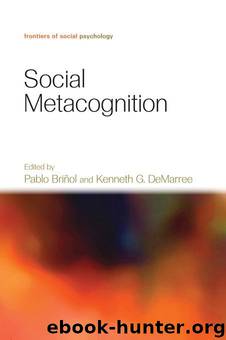Social Metacognition (Frontiers of Social Psychology) by Unknown

Author:Unknown
Language: eng
Format: mobi
ISBN: 9781135234096
Publisher: Taylor and Francis
Published: 2012-04-26T14:00:00+00:00
Figure 10.3 Mean rated inevitability of a University of North Carolina at Chapel Hill men’s basketball win (0- to 10-point scale). Participants generated thoughts supporting a Carolina win over Duke. Participants in the 3- and 12-thoughts conditions generated thoughts 1 day after the game and read previously generated thoughts 1 week afterward, respectively. (Adapted from Sanna, L. J. et al. 2009, Exp. 1. Journal of Experimental Social Psychology, 45, 940–946.)
This may be particularly likely when outcomes are especially important, striking, or impactful. At first, the initial shock of the outcome elicits strong surprise, and the conclusion is that events were very unpredictable. However, as people make sense of what happened, potential causes become highly accessible, which may result in the conclusion that the event could have been foreseen and, in fact, might or even should have been prevented. Public discourse following the 9/11 terror attacks in the United States is consistent with this conjecture (for a review, see Wirtz, 2006). Media coverage may further change the metacognitive experiences of ease associated with representing event outcomes and their causes through frequent repetition.
Mere Exposure and Affective Responses
The experience of ease or fluency may be experienced as pleasant, eliciting positive affect that can even be measured physiologically (Winkielman & Cacioppo, 2001). Positive affect derived from fluency may relate to other classic phenomena, such as the mere exposure effect (Zajonc, 1968; for a review, see Bornstein, 1989), whereby repeated exposure to an initially neutral stimulus leads to gradually increased liking and positive evaluations.2 In fact, several researchers have suggested that mere exposure effects are due to increased processing fluency and/or feelings of familiarity that result from repeated exposure (Bornstein & D’Agostino, 1994; Jacoby, Kelley, & Dywan, 1989), although these have not always been labeled as metacognitive experiences per se (see Alter & Oppenheimer, 2009).
For example, the perceptual fluency/attribution model of Bornstein and D’Agostino (1994) may explain why mere exposure effects are stronger when people are unaware that they have been exposed to the stimuli. People prefer stimuli more under brief (e.g., 5 ms) versus longer (e.g., 500 ms) exposure times. The interpretation is that once people attribute fluency to prior exposure (e.g., recognizing more exposure under longer presentation times), using ease as a cue to liking is discounted (Bornstein & D’Agostino, 1994)—an idea that also appears compatible with our present model.
Following this reasoning, future research may examine whether any variable that increases metacognitive experiences influences affect and evaluations. There is accumulating evidence for this, even under conditions of single exposure. For example, Reber, Winkielman, and Schwarz (1998) presented to participants pictures of everyday objects and manipulated processing fluency via visual priming. Depending on condition, pictures of target objects were preceded by subliminally presented highly degraded contours of either the target picture or a different picture. The target pictures that were preceded by matched contours were recognized faster, suggesting high fluency, and were liked more than pictures preceded by mismatched contours. Moreover, the effects of processing fluency were eliminated when participants attributed their positive affect
Download
This site does not store any files on its server. We only index and link to content provided by other sites. Please contact the content providers to delete copyright contents if any and email us, we'll remove relevant links or contents immediately.
What's Done in Darkness by Kayla Perrin(26597)
The Fifty Shades Trilogy & Grey by E L James(19080)
Shot Through the Heart: DI Grace Fisher 2 by Isabelle Grey(19064)
Shot Through the Heart by Mercy Celeste(18937)
Wolf & Parchment: New Theory Spice & Wolf, Vol. 10 by Isuna Hasekura and Jyuu Ayakura(17118)
Python GUI Applications using PyQt5 : The hands-on guide to build apps with Python by Verdugo Leire(16998)
Peren F. Statistics for Business and Economics...Essential Formulas 3ed 2025 by Unknown(16880)
Wolf & Parchment: New Theory Spice & Wolf, Vol. 03 by Isuna Hasekura and Jyuu Ayakura & Jyuu Ayakura(16826)
Wolf & Parchment: New Theory Spice & Wolf, Vol. 01 by Isuna Hasekura and Jyuu Ayakura & Jyuu Ayakura(16451)
The Subtle Art of Not Giving a F*ck by Mark Manson(14354)
The 3rd Cycle of the Betrayed Series Collection: Extremely Controversial Historical Thrillers (Betrayed Series Boxed set) by McCray Carolyn(14142)
Stepbrother Stories 2 - 21 Taboo Story Collection (Brother Sister Stepbrother Stepsister Taboo Pseudo Incest Family Virgin Creampie Pregnant Forced Pregnancy Breeding) by Roxi Harding(13649)
Scorched Earth by Nick Kyme(12772)
Drei Generationen auf dem Jakobsweg by Stein Pia(10965)
Suna by Ziefle Pia(10889)
Scythe by Neal Shusterman(10339)
The Ultimate Python Exercise Book: 700 Practical Exercises for Beginners with Quiz Questions by Copy(9634)
D:\Jan\FTP\HOL\Work\Alien Breed - Tower Assault CD32 Alien Breed II - The Horror Continues Manual 1.jpg by PDFCreator(9616)
De Souza H. Master the Age of Artificial Intelligences. The Basic Guide...2024 by Unknown(9553)
